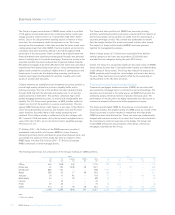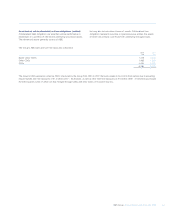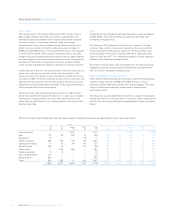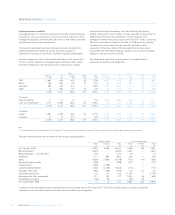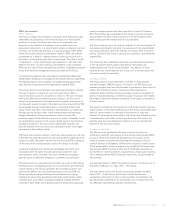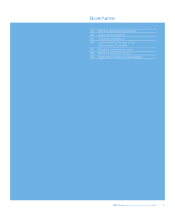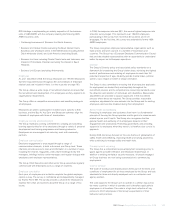RBS 2008 Annual Report Download - page 140
Download and view the complete annual report
Please find page 140 of the 2008 RBS annual report below. You can navigate through the pages in the report by either clicking on the pages listed below, or by using the keyword search tool below to find specific information within the annual report.
139
RBS Group Annual Report and Accounts 2008
SPEs and conduits
SPEs (audited)
The Group arranges securitisations to facilitate client transactions and
undertakes securitisations to sell financial assets or to fund specific
portfolios of assets. The Group also acts as an underwriter and
depositor in securitisation transactions involving both client and
proprietary transactions. In a securitisation, assets, or interests in a pool
of assets, are transferred generally to a special purpose entity (SPE)
which then issues liabilities to third party investors. SPEs are vehicles
established for a specific, limited purpose, usually do not carry out a
business or trade and typically have no employees. They take a variety
of legal forms – trusts, partnerships and companies – and fulfil many
different functions. As well as being a key element of securitisations,
SPEs are also used in fund management activities to segregate custodial
duties from the fund management advice provided by the Group.
It is primarily the extent of risks and rewards assumed that determines
whether these entities are consolidated in the Group’s financial statements.
The following section aims to address the significant exposures which
arise from the Group’s activities through specific types of SPEs.
The Group sponsors and arranges own-asset securitisations, whereby
the sale of assets or interests in a pool of assets into an SPE is
financed by the issuance of securities to investors. The pool of assets
held by the SPE may be originated by the Group, or (in the case of
whole loan programmes) purchased from third parties, and may be of
varying credit quality. Investors in the debt securities issued by the SPE
are rewarded through credit-linked returns, according to the credit
rating of their securities. The majority of securitisations are supported
through liquidity facilities, other credit enhancements and derivative
hedges extended by financial institutions, some of which offer
protection against initial defaults in the pool of assets. Thereafter, losses
are absorbed by investors in the lowest ranking notes in the priority of
payments. Investors in the most senior ranking debt securities are
typically shielded from loss, since any subsequent losses may trigger
repayment of their initial principal.
The Group also employs synthetic structures, where assets are not sold
to the SPE, but credit derivatives are used to transfer the credit risk of the
assets to an SPE. Securities may then be issued by the SPE to investors,
on the back of the credit protection sold to the Group by the SPE.
In general residential and commercial mortgages and credit card
receivables form the types of assets generally included in cash
securitisations, while corporate loans and commercial mortgages
typically serve as reference obligations in synthetic securitisations.
The Group sponsors own-asset securitisations as a way of diversifying
funding sources, managing specific risk concentrations, and achieving
capital efficiency. The Group purchases the securities issued in own-
asset securitisations set up for funding purposes. During 2008, the
Group was able to pledge AAA-rated asset-backed securities as
collateral for repurchase agreements with major central banks under
schemes such as the Bank of England’s Special Liquidity Scheme,
launched in April 2008, which allowed banks to temporarily swap high-
quality mortgage-backed and other securities for liquid UK Treasury
Bills. This practice has contributed to the Group’s sources of funding
during 2008 in the face of the contraction in the UK market for inter-
bank lending and the investor base for securitisations.
The Group typically does not retain the majority of risks and rewards of
own-asset securitisations set up for the purposes of risk diversification
and capital efficiency, where the majority of investors tend to be third
parties. Therefore, the Group is typically not required to consolidate the
related SPEs.
The Group has also established whole loan securitisation programmes
in the US and UK where assets originated by third parties are
warehoused by the Group for securitisation. The majority of these
vehicles are not consolidated by the Group, as it is not exposed to the
risks and rewards of ownership.
Conduits (audited)
The Group sponsors and administers a number of asset-backed
commercial paper (ABCP) conduits. A conduit is an SPE that issues
commercial paper and uses the proceeds to purchase or fund a pool of
assets. The commercial paper is secured on the assets and is
redeemed either by further commercial paper issuance, repayment of
assets or liquidity drawings. Commercial paper is typically short-dated –
the length of time from issuance to maturity of the paper is typically up
to three months.
The Group’s conduits can be divided into multi-seller conduits and own-
asset conduits. In line with market practice, the Group consolidates both
types of conduit where it is exposed to the majority of risks and
rewards of ownership of these entities. The Group also extends liquidity
commitments to multi-seller conduits sponsored by other banks, but
typically does not consolidate these entities as it is not exposed the
majority of the risks and rewards.
Funding and liquidity
The Group’s most significant multi-seller conduits have thus far
continued to fund the vast majority of their assets solely through ABCP
issuance. There were significant disruptions to the liquidity of the
financial markets during the year following the bankruptcy filing of
Lehman Brothers in September 2008 and this required a small amount
of the assets held in certain conduits to be funded by the Group rather
than through ABCP issuance. By the end of 2008 there had been an
improvement in market conditions, supported by central bank initiatives,
which enabled normal ABCP funding to replace this Group funding of
the conduits.
The average maturity of ABCP issued by the Group’s conduits as at 31
December 2008 was 72.1 days (2007 – 60.9 days).
The total assets held by the Group’s sponsored conduits are £49.9
billion (2007 – £48.1 billion). Since these liquidity facilities are
sanctioned on the basis of total conduit purchase commitments, the
liquidity facility commitments will exceed the level of assets held, with
the difference representing undrawn commitments.



